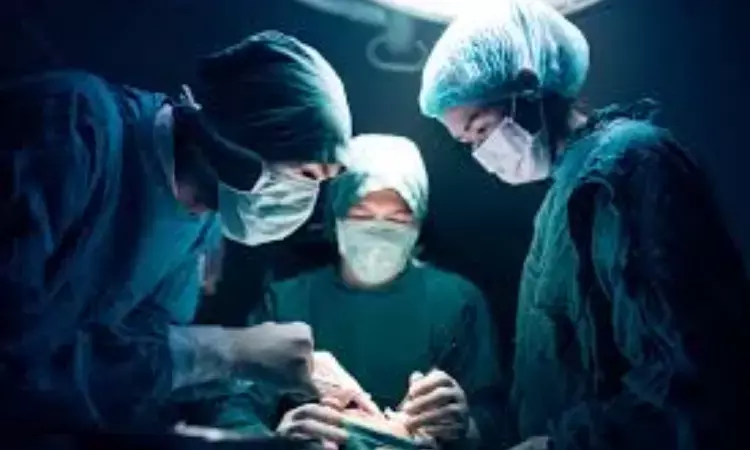- Home
- Medical news & Guidelines
- Anesthesiology
- Cardiology and CTVS
- Critical Care
- Dentistry
- Dermatology
- Diabetes and Endocrinology
- ENT
- Gastroenterology
- Medicine
- Nephrology
- Neurology
- Obstretics-Gynaecology
- Oncology
- Ophthalmology
- Orthopaedics
- Pediatrics-Neonatology
- Psychiatry
- Pulmonology
- Radiology
- Surgery
- Urology
- Laboratory Medicine
- Diet
- Nursing
- Paramedical
- Physiotherapy
- Health news
- Fact Check
- Bone Health Fact Check
- Brain Health Fact Check
- Cancer Related Fact Check
- Child Care Fact Check
- Dental and oral health fact check
- Diabetes and metabolic health fact check
- Diet and Nutrition Fact Check
- Eye and ENT Care Fact Check
- Fitness fact check
- Gut health fact check
- Heart health fact check
- Kidney health fact check
- Medical education fact check
- Men's health fact check
- Respiratory fact check
- Skin and hair care fact check
- Vaccine and Immunization fact check
- Women's health fact check
- AYUSH
- State News
- Andaman and Nicobar Islands
- Andhra Pradesh
- Arunachal Pradesh
- Assam
- Bihar
- Chandigarh
- Chattisgarh
- Dadra and Nagar Haveli
- Daman and Diu
- Delhi
- Goa
- Gujarat
- Haryana
- Himachal Pradesh
- Jammu & Kashmir
- Jharkhand
- Karnataka
- Kerala
- Ladakh
- Lakshadweep
- Madhya Pradesh
- Maharashtra
- Manipur
- Meghalaya
- Mizoram
- Nagaland
- Odisha
- Puducherry
- Punjab
- Rajasthan
- Sikkim
- Tamil Nadu
- Telangana
- Tripura
- Uttar Pradesh
- Uttrakhand
- West Bengal
- Medical Education
- Industry
Short or long-stitch technique which is better for midline laparotomy?

Germany: After midline laparotomy, incisional hernia remains a frequent problem. A recent study in the British Journal of Surgery found that between short and long stitches, the 1-year incisional hernia development was relatively low with clinical but no statistical differences.
René H Fortelny, Sigmund Freud Privat Universität, Med. Fakultät, Vienna, Austria, and colleagues conducted a prospective, multicentre, parallel-group, double-blind, randomized, controlled superiority trial -- ESTOIH to compare a short stitch to standard loop closure using an ultra-long-term absorbent elastic suture material.
Adult patients were randomly assigned to fascial closure using a short stitch (5 to 8 mm every 5 mm, USP 2-0, single thread HR 26 mm needle) or long stitch technique (10 mm every 10 mm, USP 1, double loop, HR 48 mm needle) with a poly-4-hydroxybutyrate-based suture material (Monomax) by computer-generated sequence. The primary outcome was incisional hernia assessed by ultrasound 1 year after surgery.
Based on the study, the researchers found the following:
- The trial randomized 425 patients to short (n = 215) or long stitch technique (n = 210) of whom 414 (97.4 percent) completed 1 year of follow-up.
- In the short stitch group, the fascia was closed with more stitches (46 (12 s.d.) versus 25 (7 s.d.)) and a higher suture-to-wound length ratio (5.3 (2.2 s.d.) versus 4.0 (1.3 s.d.)).
- At 1 year, seven of 210 (3.3 percent) patients in the short and 13 of 204 (6.4 percent) patients in the long stitch group developed incisional hernia (odds ratio 1.97).
"The need for surgical repair was equal in both groups, despite the greater number of hernias in the long stitch group," the researchers wrote, "which raises the question of whether a reduced number of hernias can translate into a clinical advantage."
"In this regard, the general quality of life, pain, and self-care after 1 year was better for the short stitch group," they conclude.
Reference:
René H Fortelny, Dorian Andrade, Malte Schirren, Petra Baumann, Stefan Riedl, Claudia Reisensohn, Jan Ludolf Kewer, Jessica Hoelderle, Andreas Shamiyeh, Bettina Klugsberger, Theo David Maier, Guido Schumacher, Ferdinand Köckerling, Ursula Pession, Anna Hofmann, Markus Albertsmeier, Effects of the Short Stitch Technique for Midline Abdominal Closure on Incisional Hernia (ESTOIH): Randomized Clinical Trial, British Journal of Surgery, 2022;, znac194, https://doi.org/10.1093/bjs/znac194
Dr Kamal Kant Kohli-MBBS, DTCD- a chest specialist with more than 30 years of practice and a flair for writing clinical articles, Dr Kamal Kant Kohli joined Medical Dialogues as a Chief Editor of Medical News. Besides writing articles, as an editor, he proofreads and verifies all the medical content published on Medical Dialogues including those coming from journals, studies,medical conferences,guidelines etc. Email: drkohli@medicaldialogues.in. Contact no. 011-43720751


